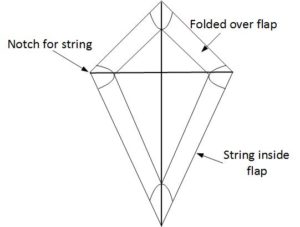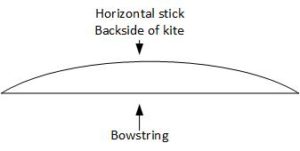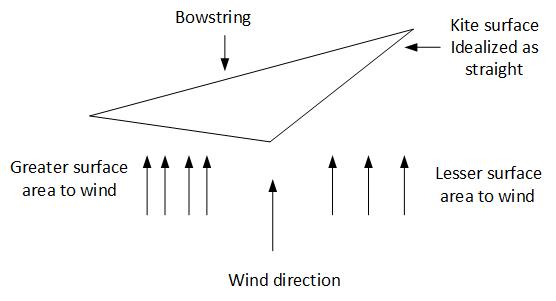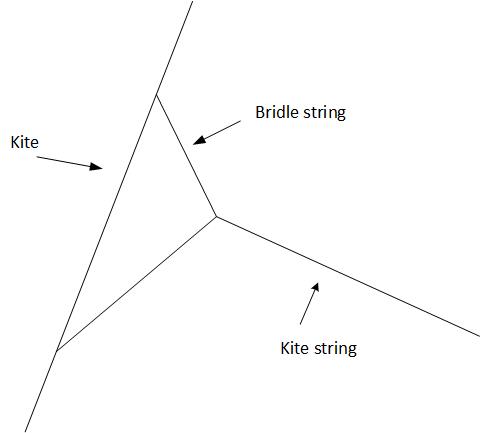As a youth, I found a special joy in flying kites. Not in just getting one up into the air but in seeing how high and far away they could become. Somehow, there was a special serenity in leaning back against a tree while a breeze was blowing and doing nothing but watching my sentinel in the sky.
Nowadays one can spend a serious amount of money buying fancy kites of various designs. Some are made of plastic and others of cloth. Some have fancy non-aerodynamic shapes but boldly display superheroes or cute little animals.
In my day, kites were purchased from the local dime store. They came in two types: diamond or box. The diamond kit cost ten cents, or maybe it was fifteen, and the box kite considerably more.
The diamond, or Malay, kite consisted of two sticks of balsa wood, one about two thirds as long as the other and bound together by a single loosely fitting metal band. You rotated one of the sticks until they were at right angles to one another, forming a simple cross.

The sticks were packaged rolled up in a very light paper shaped like two triangles placed together base to base. A small strip of each outer edge was folded and pasted over a loop of string that ran around the circumference. The string was visible at each of the four corners of the kite.
Both of the sticks had notches in each end, and the four exposed portions of the string loops were inserted into them. If one pierced a small hole in the paper covering near where the two sticks crossed and tied a kite string around the vertical one, the kite was reputed “ready to fly.”
Well not quite. Although the diamond kite was touted as a tailless kite as originally assembled , in my experience, it was a very poor flyer.
Many of the small plastic kites available today have the same characteristics. If the wind is too light, then it is impossible to get the kite high enough by running to escape the turbulent air near the ground caused by nearby buildings and trees. If the wind is too strong, the kite’s inherent instability causes it careen around and eventually crash breaking the sticks or ripping the plastic or whatever. There is a sweet spot when the wind velocity is just right and the kite will fly, but it is extremely narrow.
From time to time I wonder how many times a parent has taken a young child to a city park planning to introduce them to the joy of seeing their possession defying gravity and soaring into the sky only to give up in frustration after a few dozen failed attempts.
Yes, the wind has to be strong enough that the weight of the kite can become airborne. But more than that, the kite must be stable in all three directions of motion – pitching up and down, yawing from left to right, and rolling from side to side.
If properly rigged and the wind is strong enough, however, a simple diamond kite can be launched by simply holding it front of you with your back to the wind, gently releasing it and letting it rise.
Yaw
The first thing to do is attach an additional string on the backside of the kite running from one end of the horizontal stick to the other. The length of the string is shorter than the stick itself so that the it becomes bowed in a gentle arc.

Now, when the wind is blowing on the kite, what is called a dihedral angle is produced. A single flat surface is not presented to the wind but two slanted ones. If, because of a swirl of the air, the side of the kite on the left of the vertical stick is pushed away from you, it presents less surface to the wind. At the same time, the rotation causes the right hand side to present more.
Then there is greater wind pressure on the right side than on the left, and the kite rotates back to a position in which the forces are balanced. This is a perfect example of what engineers call “negative feedback” — a system automatically correcting itself when things get out of whack.
The more you bow the kite, of course, the more stable it becomes against yawing to the right or left. However, at the same time, less and less surface area faces the wind and the ability of the kite to lift diminishes. A modest amount of bowing is all that is needed for most kites.
Bowing a kite is no secret. Although the diamond kite is reputed to be of Malaysian origin, the Japanese were bowing their kites for centuries as well.
Pitch
The second thing to do is to disregard any instruction to attach the kite string to the kite at only a single point. If a gust of wind hits the larger triangle of the kite below the point of attachment, there is nothing to stop it from continuing to rise until the entire kite presents very little surface to the wind, and it starts plummeting to the ground. Another gust catches it as it falls and crazy things begin to happen.
Two points of attachment should be used and not just one. Attach a short piece of string to the vertical stick about half way between the horizontal one and the top of the kite. Attach the other end halfway between the horizontal stick and the bottom. Finally attach the kite string itself to this new one producing a triangle when the wind blows.

This bridle, as it is called, also creates a negative feedback. If a gust blows on the bottom half of the kite, the tension in the lower portion of the string becomes greater than the upper and the kite is righted.
Bridle strings too are no secret. The only tricky part is adjusting the point where the kite string is attached to the triangle so that the angle the kite makes in the wind is a good one. Attach too high and the kite flies to horizontally and has little lift. Attach too low and it has too little lift as well.
Roll
This one is the killer. Kites sold in stores nowadays have a few little ribbons of plastic streamer hanging at the bottom that serve no useful function at all. The purpose of a tail is to stop the kite from rolling. In my day, the conventional wisdom was that it was the weight of the tail that prevented a kite from starting to pivot from its upright position and start to rotate about the kite string. A length of knotted rags, the heavier the better was the thing to use.
The thing is that if you want a kite to soar so high that you can barely see it, adding a lot of weight is not what should be done. The wind is what holds everything loft, the kite, the tail, and the kite string. The less weight devoted to the kite and tail, the more that can be used to lift string.
I don’t remember if I thought of this myself or one of my parents told me what to do. But here is the secret that will you a champion kite flyer in the eyes of your friends.
Get an old bed sheet, one, say, about eight feet across. Starting at one edge begin tearing a half-inch strip of material away from the sheet. However — this is the important part — do not complete the tear. When you get to about an inch from the other side, stop what you are doing and begin another tear about a half inch separated from the first and going in the opposite direction. Do this about six or seven times and complete the final tear all the way across.
Now you have a light tail that is about 50 feet long, but with no useless knots. It will produce sufficient wind resistance to rotational forces that your kite will be stable against rolls.
The Endorphin Rush
On a blustery day, take a properly built diamond kite to an open area. Lay out the tail in a straight line on the ground. Put your back to the wind and slowly let your kite leave your hand. Watch it majestically rise into the air with no twitching, no bobbing, and no rotation — a stern monarch of the sky. Let all of your string out until it can barely be seen. Get a comfortable place to sit and marvel at what you have done.
PS
In the modern age, there are restrictions against flying kites weighting more than five pounds above 500 feet. Near airports, this applies regardless of weight.
PPS
Larger kites can lift great weights. If they were not tethered, they would be a great means of transportation. But, since they are, one would have to resort to things like balloons. Ballons can be made out of many different substances. One such example, using lead, occurs in Riddle of the Seven Realms
© 2016 Lyndon M. Hardy
Input your name and email to get a .pdf download of this post.





